Improving Output Efficiency of InGaN-Based MQW Green Laser Diodes by Modulating Indium Content of Quantum Barriers and Using Composite Lower Waveguide Layers
Abstract
:1. Introduction
2. Device Structures and Methods
3. Results and Discussion
3.1. Improvement of Output Characteristics by Modulating Indium Content in Quantum Barriers
3.2. Output Characteristics Improvement by Using Composite LWG Layer
4. Conclusions
Author Contributions
Funding
Institutional Review Board Statement
Informed Consent Statement
Data Availability Statement
Conflicts of Interest
References
- Yang, J.; Zhao, D.; Liu, Z.; Liang, F.; Chen, P.; Duan, L.; Wang, H.; Shi, Y. A 357.9 nm GaN/AlGaN multiple quantum well ultraviolet laser diode. J. Semicond. 2022, 43, 010501. [Google Scholar] [CrossRef]
- Zhi, T.; Tao, T.; Liu, X.; Xue, J.; Wang, J.; Tao, Z.; Li, Y.; Xie, Z.; Liu, B. Low-threshold lasing in a plasmonic laser using nanoplate InGaN/GaN. J. Semicond. 2021, 42, 122803. [Google Scholar] [CrossRef]
- Liang, F.; Zhao, D.; Liu, Z.; Chen, P.; Yang, J.; Duan, L.; Shi, Y.; Wang, H. GaN-based blue laser diode with 6.0 W of output power under continuous-wave operation at room temperature. J. Semicond. 2021, 42, 112801. [Google Scholar] [CrossRef]
- Nakatsu, Y.; Nagao, Y.; Hirao, T.; Hara, Y.; Masui, S.; Yanamoto, T.; Nagahama, S.I. Blue and green InGaN semiconductor lasers as light sources for displays. In Proceedings of the Conference on Gallium Nitride Materials and Devices XV, San Francisco, CA, USA, 4–6 February 2020. [Google Scholar] [CrossRef]
- Masui, S.; Nakatsu, Y.; Kasahara, D.; Nagahama, S. Recent Improvement in Nitride Lasers. In Proceedings of the Conference on Gallium Nitride Materials and Devices XII, San Francisco, CA, USA, 30 January–2 February 2017. [Google Scholar] [CrossRef]
- Baten, M.Z.; Alam, S.; Sikder, B.; Aziz, A. III-Nitride Light-Emitting Devices. Photonics 2021, 8, 430. [Google Scholar] [CrossRef]
- Sizov, D.; Bhat, R.; Zah, C.-E. Gallium Indium Nitride-Based Green Lasers. J. Lightwave Technol. 2012, 30, 679–699. [Google Scholar] [CrossRef]
- Cheng, Y.; Liu, J.; Zhang, L.; Jiang, D.; Tian, A.; Zhang, F.; Feng, M.; Wen, P.; Zhou, W.; Zhang, S.; et al. Suppression of recombination in waveguide in c-plane InGaN-based green laser diodes. Superlattices Microstruct. 2017, 111, 1121–1125. [Google Scholar] [CrossRef]
- Jiang, L.; Liu, J.; Zhang, L.; Qiu, B.; Tian, A.; Hu, L.; Li, D.; Huang, S.; Zhou, W.; Ikeda, M.; et al. Suppression of substrate mode in GaN-based green laser diodes. Opt. Express 2020, 28, 15497–15504. [Google Scholar] [CrossRef] [PubMed]
- Liang, F.; Zhao, D.; Jiang, D.; Liu, Z.; Zhu, J.; Chen, P.; Yang, J.; Liu, W.; Li, X.; Liu, S.; et al. Suppression of optical field leakage to GaN substrate in GaN-based green laser diode. Superlattices Microstruct. 2017, 102, 484–489. [Google Scholar] [CrossRef]
- Hou, Y.; Zhao, D.; Liang, F.; Wang, X.; Yang, J.; Chen, P.; Liu, Z. Improving optical and electrical properties of InGaN-based green laser diodes by graded-compositional waveguide structure. Opt. Mater. 2020, 110, 110477. [Google Scholar] [CrossRef]
- Yang, J.; Zhao, D.; Jiang, D.; Chen, P.; Zhu, J.; Liu, Z.; Li, X.; Liang, F.; Liu, W.; Liu, S.; et al. Performance Enhanced by Inserting an InGaN/GaN Shallower-Quantum Well Layer in InGaN Based Green Laser Diodes. IEEE Photonics J. 2017, 9, 1–8. [Google Scholar] [CrossRef] [Green Version]
- Cheng, Y.; Liu, J.; Tian, A.; Zhang, F.; Feng, M.; Hu, W.; Zhang, S.; Ikeda, M.; Li, D.; Zhang, L.; et al. Hole transport in c-plane InGaN-based green laser diodes. Appl. Phys. Lett. 2016, 109, 092104. [Google Scholar] [CrossRef]
- Sizov, D.S.; Bhat, R.; Zakharian, A.; Kechang, S.; Allen, D.E.; Coleman, S.; Chung-en, Z. Carrier Transport in InGaN MQWs of Aquamarine- and Green-Laser Diodes. IEEE J. Sel. Top. Quantum Electron. 2011, 17, 1390–1401. [Google Scholar] [CrossRef]
- Sizov, D.S.; Bhat, R.; Zakharian, A.; Napierala, J.; Song, K.; Allen, D.; Zah, C.-E. Impact of Carrier Transport on Aquamarine–Green Laser Performance. Appl. Phys. Express 2010, 3, 122101. [Google Scholar] [CrossRef]
- Yang, J.; Zhao, D.; Zongshun, L.; Jiang, D.-S.; Jianjun, Z.; Chen, P.; Liang, F.; Liu, S.T.; Liu, W.; Xing, Y.; et al. Suppression the Leakage of Optical Field and Carriers in GaN-based Laser Diodes by using InGaN Barrier Layers. IEEE Photonics J. 2018, 10, 1. [Google Scholar] [CrossRef]
- Laws, G.M.; Larkins, E.C.; Harrison, I.; Molloy, C.; Somerford, D. Improved refractive index formulas for the AlxGa1−xN and InyGa1−yN alloys. J. Appl. Phys. 2001, 89, 1108–1115. [Google Scholar] [CrossRef]
- Alahyarizadeh, G.; Amirhoseiny, M.; Hassan, Z. Effect of different EBL structures on deep violet InGaN laser diodes performance. Opt. Laser Technol. 2016, 76, 106–112. [Google Scholar] [CrossRef]
- Kuramoto, C.S.M.; Futagawa, N.; Nido, M.; Yamaguchi, A.A. Reduction of Internal Loss and Threshold Current in a Laser Diode with a Ridge by Selective Re-Growth (RiS-LD). Phys. Status Solidi (A) 2002, 192, 329–334. [Google Scholar] [CrossRef]
- Lermer, T.; Schillgalies, M.; Breidenassel, A.; Queren, D.; Eichler, C.; Avramescu, A.; Müller, J.; Scheibenzuber, W.; Schwarz, U.; Lutgen, S.; et al. Waveguide design of green InGaN laser diodes. Phys. Status Solidi (A) 2010, 207, 1328–1331. [Google Scholar] [CrossRef]
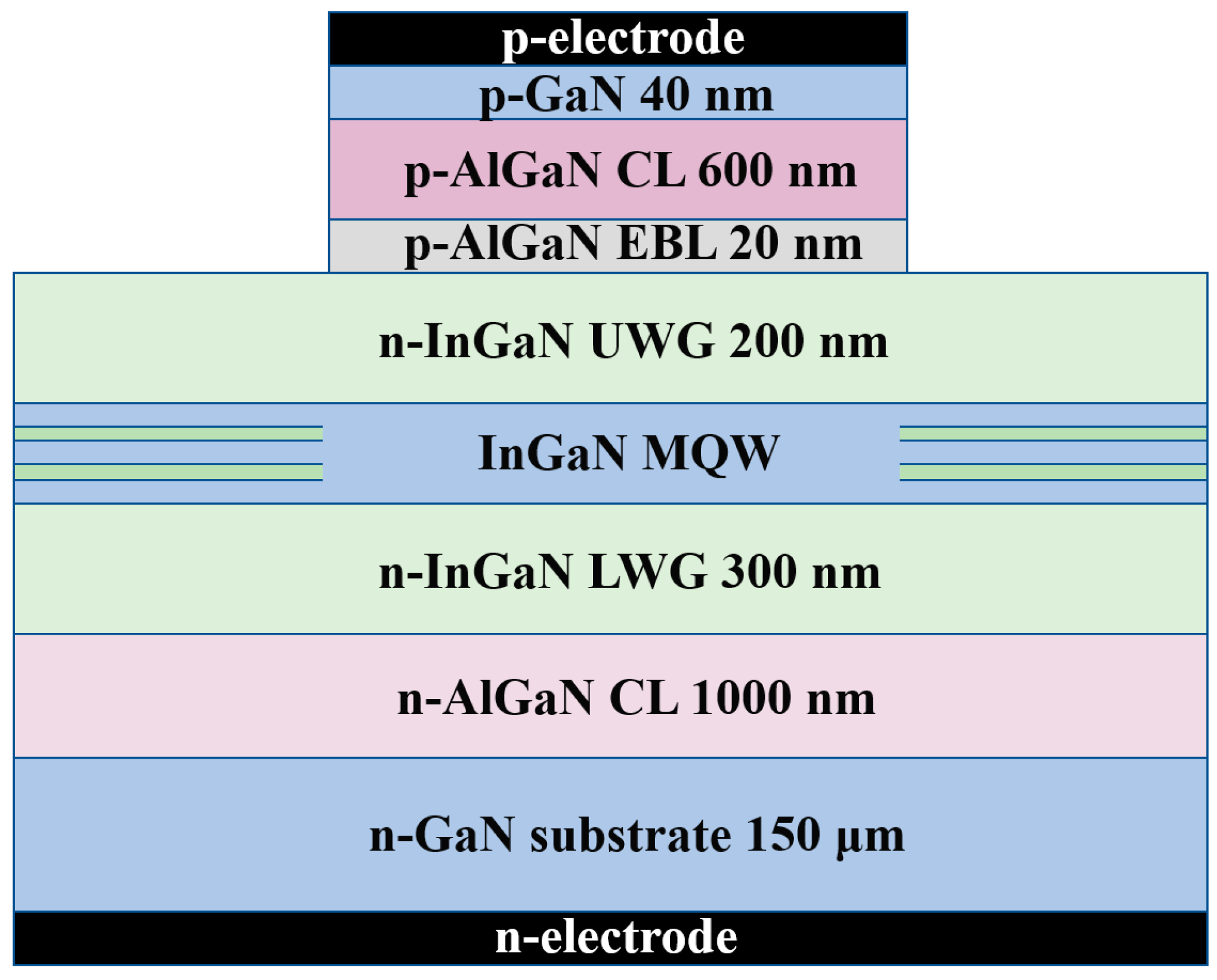
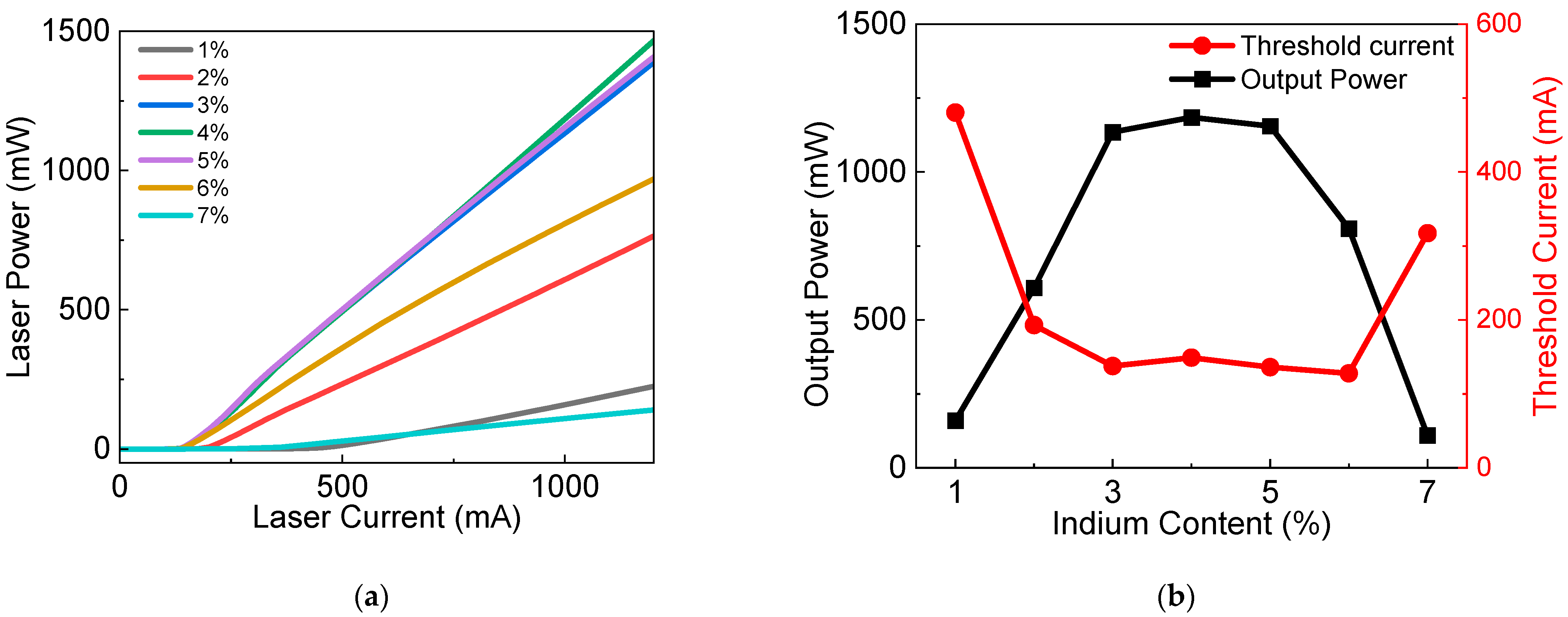
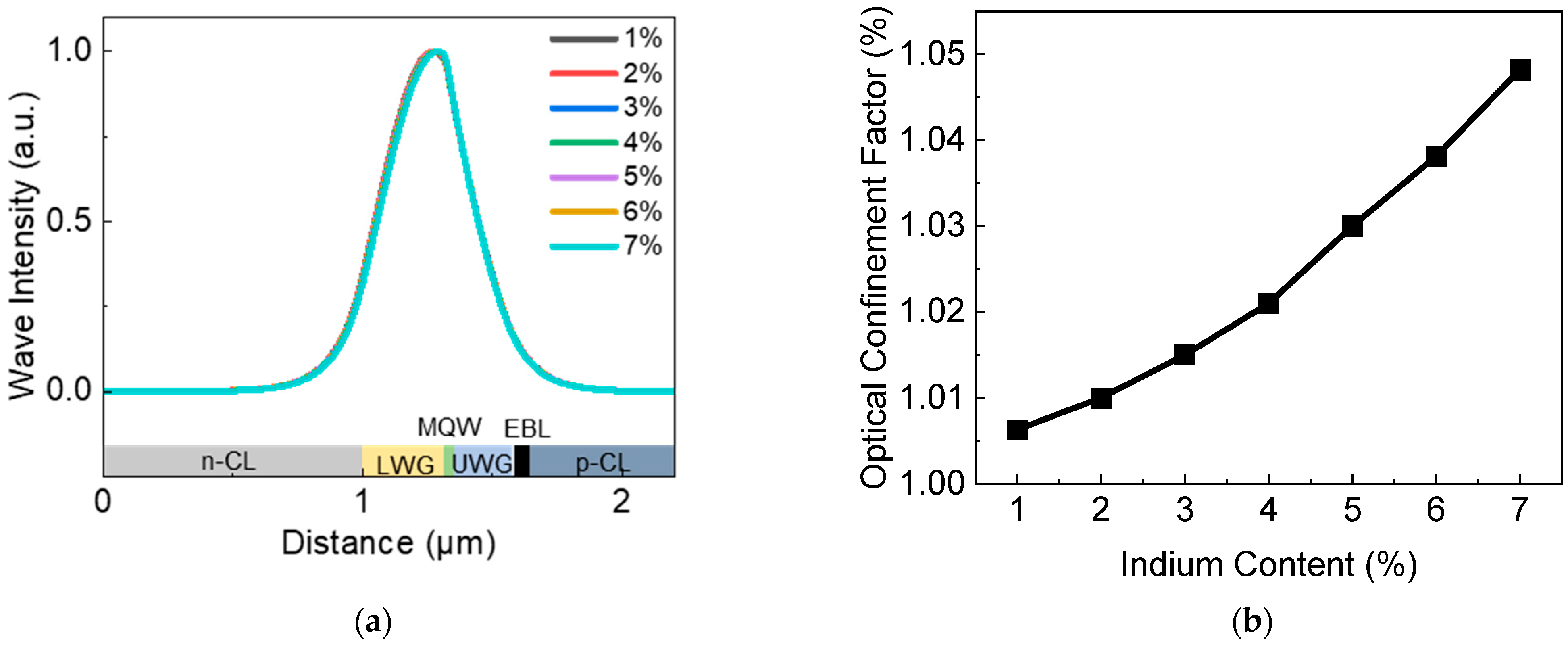
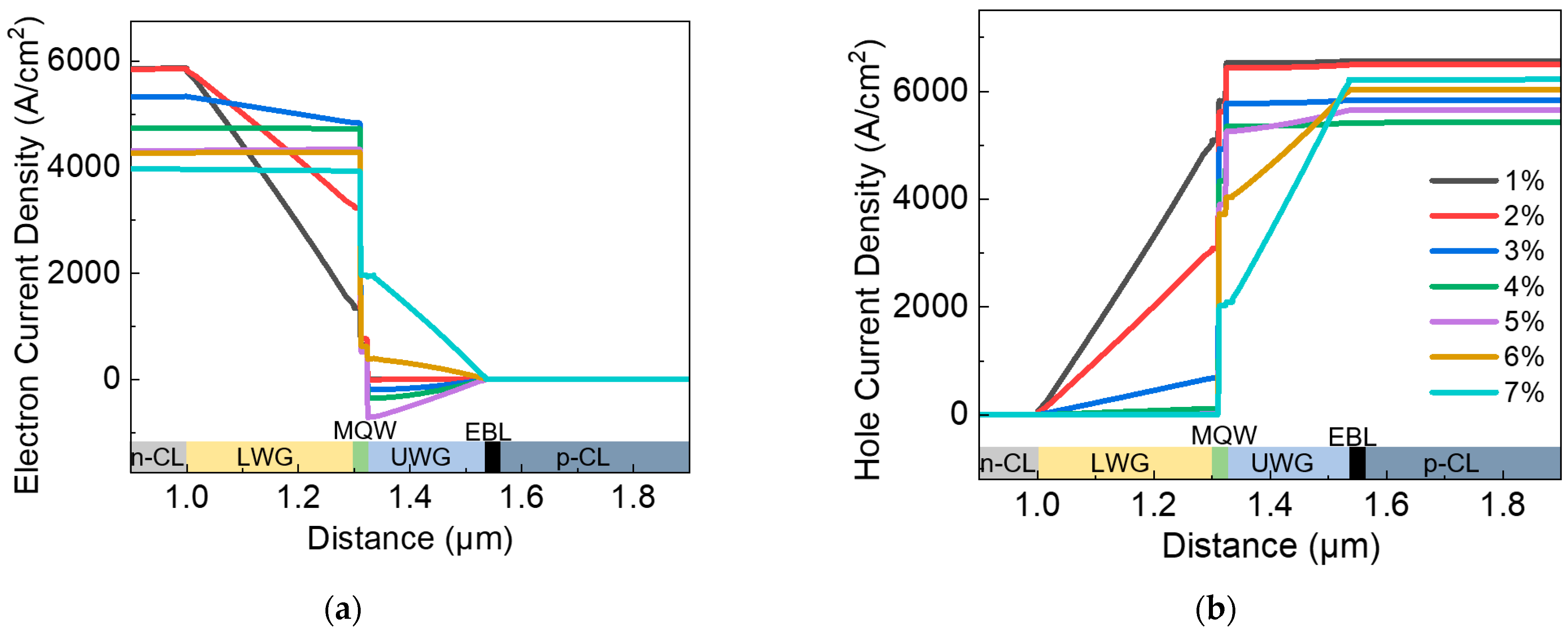
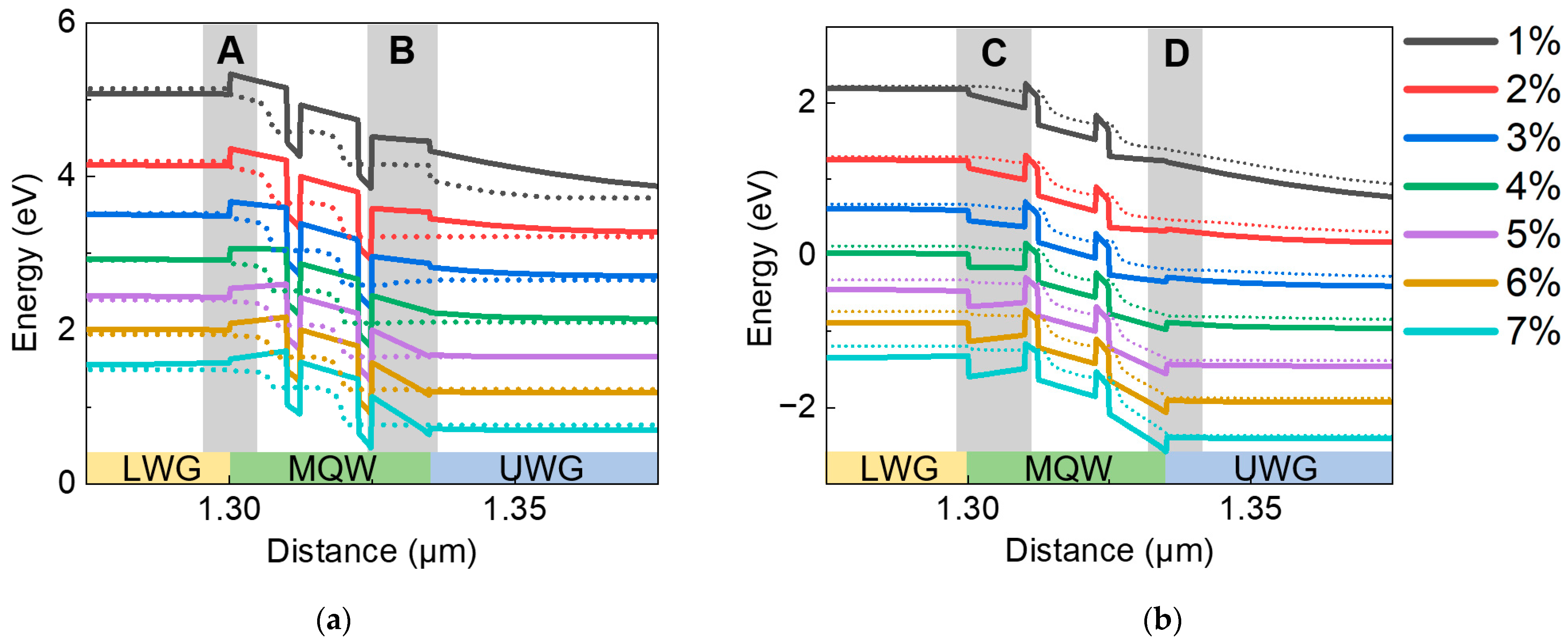

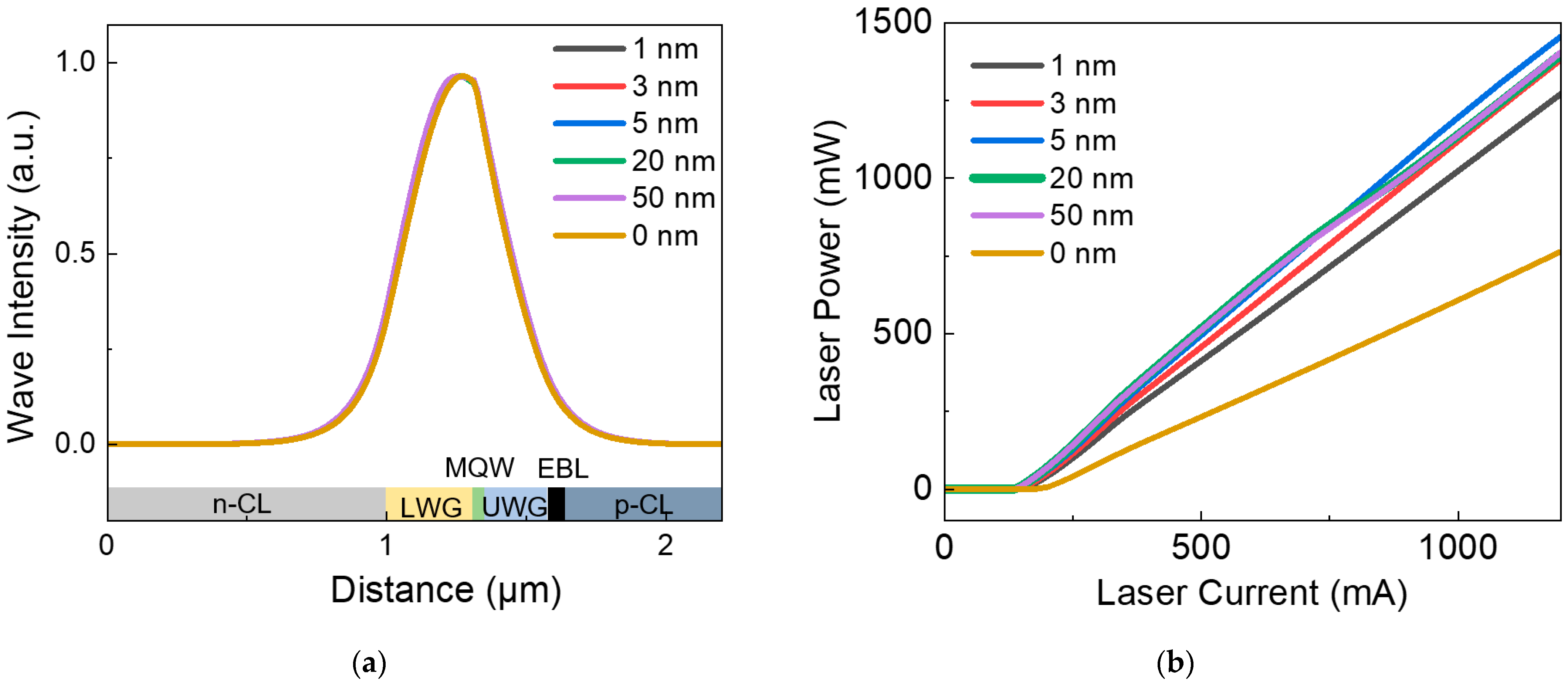

Publisher’s Note: MDPI stays neutral with regard to jurisdictional claims in published maps and institutional affiliations. |
© 2022 by the authors. Licensee MDPI, Basel, Switzerland. This article is an open access article distributed under the terms and conditions of the Creative Commons Attribution (CC BY) license (https://creativecommons.org/licenses/by/4.0/).
Share and Cite
Chen, Z.; Liang, F.; Zhao, D.; Yang, J.; Chen, P.; Jiang, D. Improving Output Efficiency of InGaN-Based MQW Green Laser Diodes by Modulating Indium Content of Quantum Barriers and Using Composite Lower Waveguide Layers. Nanomaterials 2022, 12, 2581. https://doi.org/10.3390/nano12152581
Chen Z, Liang F, Zhao D, Yang J, Chen P, Jiang D. Improving Output Efficiency of InGaN-Based MQW Green Laser Diodes by Modulating Indium Content of Quantum Barriers and Using Composite Lower Waveguide Layers. Nanomaterials. 2022; 12(15):2581. https://doi.org/10.3390/nano12152581
Chicago/Turabian StyleChen, Zhenyu, Feng Liang, Degang Zhao, Jing Yang, Ping Chen, and Desheng Jiang. 2022. "Improving Output Efficiency of InGaN-Based MQW Green Laser Diodes by Modulating Indium Content of Quantum Barriers and Using Composite Lower Waveguide Layers" Nanomaterials 12, no. 15: 2581. https://doi.org/10.3390/nano12152581
APA StyleChen, Z., Liang, F., Zhao, D., Yang, J., Chen, P., & Jiang, D. (2022). Improving Output Efficiency of InGaN-Based MQW Green Laser Diodes by Modulating Indium Content of Quantum Barriers and Using Composite Lower Waveguide Layers. Nanomaterials, 12(15), 2581. https://doi.org/10.3390/nano12152581






